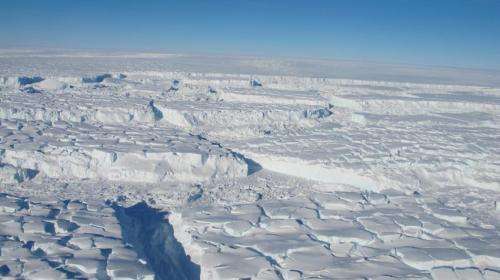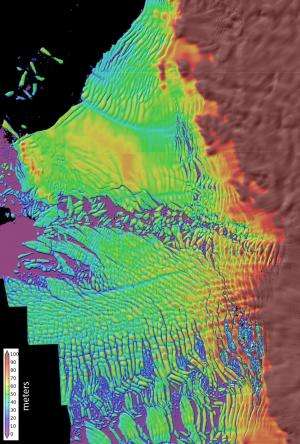West Antarctic Ice Sheet collapse is under way

The West Antarctic Ice Sheet, which holds enough water to raise global seas by several feet, is thinning. Scientists have been warning of its collapse, based on theories, but with few firm predictions or timelines.
University of Washington researchers used detailed topography maps and computer modeling to show that the collapse appears to have already begun. The fast-moving Thwaites Glacier will likely disappear in a matter of centuries, researchers say, raising sea level by nearly 2 feet. That glacier also acts as a linchpin on the rest of the ice sheet, which contains enough ice to cause another 10 to 13 feet (3 to 4 meters) of global sea level rise. The study will be published on May 16 in Science.
"There's been a lot of speculation about the stability of marine ice sheets, and many scientists suspected that this kind of behavior is under way," said Ian Joughin, a glaciologist at the UW's Applied Physics Laboratory. "This study provides a more quantitative idea of the rates at which the collapse could take place."
The good news is that while the word "collapse" implies a sudden change, the fastest scenario is 200 years, and the longest is more than 1,000 years. The bad news is that such a collapse may be inevitable.
"Previously, when we saw thinning we didn't necessarily know whether the glacier could slow down later, spontaneously or through some feedback," Joughin said. "In our model simulations it looks like all the feedbacks tend to point toward it actually accelerating over time; there's no real stabilizing mechanism we can see."

Earlier warnings of collapse had been based on a simplified model of ice sitting in an inward-sloping basin. The topography around Antarctica, however, is complex. The new study used airborne radar, developed at the University of Kansas with funding from the National Science Foundation, to image through the thick ice and map the topography of the underlying bedrock, whose shape controls the ice sheet's long-term stability. The mapping was done as part of NASA's Operation IceBridge, and included other instruments to measure the height of the ice sheet's rapidly thinning surface. In some places Thwaites Glacier has been losing tens of feet, or several meters, of elevation per year.
UW researchers combined that data with their own satellite measurements of ice surface speeds. Their computer model was able to reproduce the glacier's ice loss during the past 18 years, and they ran the model forward under different amounts of ocean-driven melting. The place where the glacier meets land, the grounding line, now sits on a shallower ridge with a depth of about 2,000 feet (600 meters). Results show that as the ice edge retreats into the deeper part of the bay, the ice face will become steeper and, like a towering pile of sand, the fluid glacier will become less stable and collapse out toward the sea.
"Once it really gets past this shallow part, it's going to start to lose ice very rapidly," Joughin said.
The study considered future scenarios using faster or slower melt rates depending on the amount of future warming. The fastest melt rate led to the early stages lasting 200 years, after which the rapid-stage collapse began. The slowest melt rate kept most of the ice for more than a millennium before the onset of rapid collapse. The most likely scenarios may be between 200 and 500 years, Joughin said.
"All of our simulations show it will retreat at less than a millimeter of sea level rise per year for a couple of hundred years, and then, boom, it just starts to really go," Joughin said.
Researchers did not model the more chaotic rapid collapse, but the remaining ice is expected to disappear within a few decades.
The thinning of the ice in recent decades is most likely related to climate change, Joughin said. More emissions would lead to more melting and faster collapse, but other factors make it hard to predict how much time we could buy under different scenarios.
More information: "Marine Ice Sheet Collapse Potentially Underway for the Thwaites Glacier Basin, West Antarctica," by I. Joughin et al. Science, 2014.
Journal information: Science
Provided by University of Washington



















